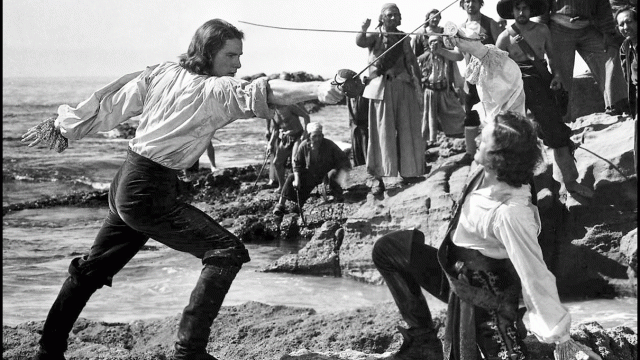It almost sounds like a “walk into a bar” joke: three actors — a swashbuckler, Sherlock Holmes, and Melanie Hamilton — walk onto the set of a movie and meet for the first time. Two of the stars were relative unknowns, but that wouldn’t be the case after Captain Blood arrived in theaters. Newcomers Errol Flynn and Olivia de Havilland are joined by up-and-coming Basil Rathbone as the dangerous, sexy adversary (everyone freaking out about the sexy bad guys in Star Wars, Shadow and Bone, etc. probably have Rathbone to blame). The formula worked so well that all three were cast in The Adventures of Robin Hood, released three years later.
Watching Captain Blood, the film’s success is no surprise. Based on a popular historical novel by Italian-English author Rafael Sabatini, the movie has plenty of action, intrigue, sword fights, and slavery — yes, slavery. In the wake of the ill-fated Monmouth Rebellion, Flynn’s Irish doctor has been sentenced to a life of servitude in the West Indies and is only spared from a deeply unfortunate fate by his medical knowledge and de Havilland’s protection. English politics set up the plot, but the real fun is watching de Havilland and Flynn square off, first when de Havilland’s character buys him on a whim* and later in the movie, when the tables are turned and Flynn has the upper hand. They play ally and adversary — sometimes both at once — and both of them are more than game for the broad, dramatic twists and turns of the story. They both look fantastic in period costume, too.
Of course, Rathbone is also beautifully suited to the world of Captain Blood. A champion fencer, he taught his co-star Flynn, and their battles are another highlight. Add to that some roaring sea battles (a few including recycled footage from the 1924 silent The Sea Hawk) and a happy ending, and you’ve got a movie that made $1.462 million in profit — and that under Hollywood accounting.
It’s been overshadowed by The Adventures of Robin Hood, which has more colorful battles (and is literally in color) and a more famous lead character, but Captain Blood is great swashbuckling fun and lets de Havilland really cut loose in a way she didn’t always get to as a stunningly beautiful leading actress. You can totally believe that she got the best of Ryan Murphy eight decades later. Like many historical accounts, Captain Blood makes light of a dark period in history, but if you’re able to let that slide, it’s perfect for a summer afternoon.
* To be fair, she’s looking out for him, too; this movie has an interesting side theme of the compromises people in broken systems are forced to make. This is, of course, never resolved by systematic reform, but at least there’s some poetic justice here and there.
Bonus Pride content: Basil Rathbone was arrested, along with everyone else in his cast (and everyone in the cast of Mae West’s SEX), at a 1926 performance of The Captive. Charges were eventually dropped but Rathbone was reportedly outraged by the whole business, feeling that homosexuality should be brought into the open. He certainly seems to have acquitted himself more nobly than his costar Helen Menken, who got into a huge fight with West in the back of the police van after the arrest.


